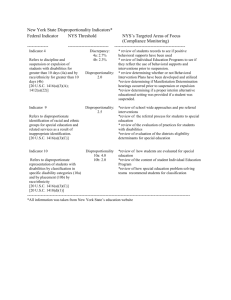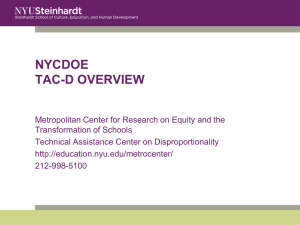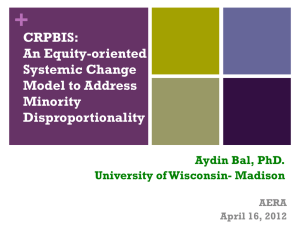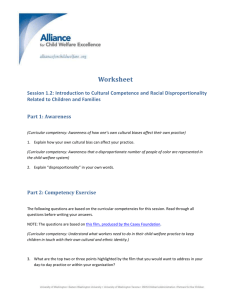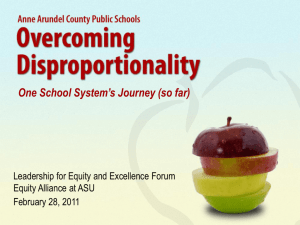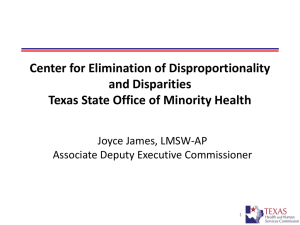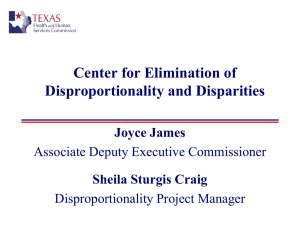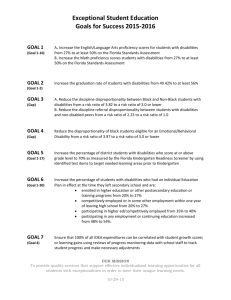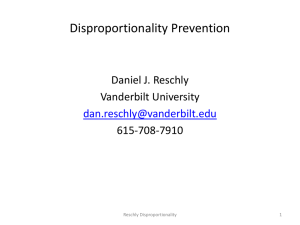View Power Point
advertisement
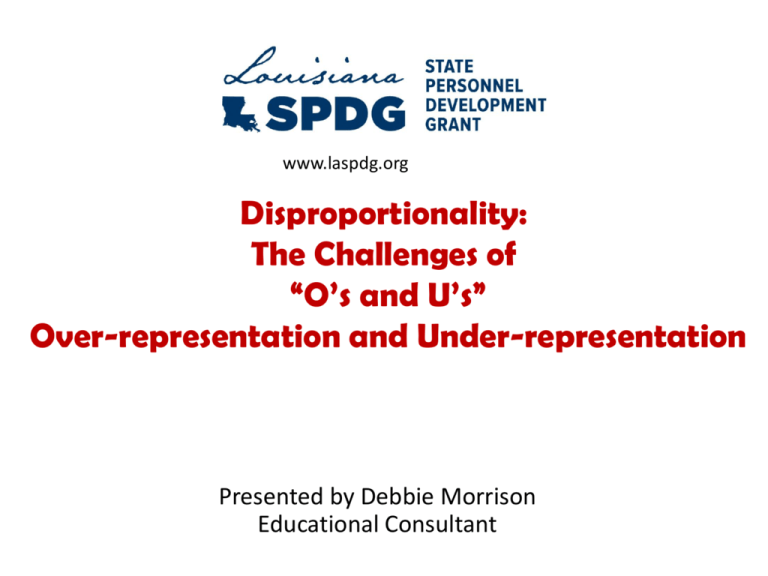
www.laspdg.org Disproportionality: The Challenges of “O’s and U’s” Over-representation and Under-representation Presented by Debbie Morrison Educational Consultant Considerations This webinar is being recorded and will be available for viewing at www.laspdg.org If you need to ask a question, please use the Chat Pod on your screen Roll Call • At this time, EVERYONE please use your chat pod (if you haven’t already) and let us know what district/LEA you are representing • If multiple people are listening in the same room, please indicate their names as well People First Language “People First Language puts the person before the disability and describes what a person has, not who a person is.” Kathie Snow. (n.d.) A few words about People First Language. Disability is Natural. Retrieved August 1, 2012 from http://www.disabilityisnatural.com/images/PDF/pfl-sh09.pdf Disproportionality What is it?????? Disproportionality is the over or underrepresentation in special and gifted education of a given population group often defined by racial and ethnic backgrounds…” “ (EMSTAC:www.emstac.org) What is Disproportionality? % of students of a specific ethnicity or race Overrepresentation In special education In school’s population What is Disproportionality? % of students of a specific ethnicity or race Underrepresentation In special education In school’s population Let’s Take a Poll Does your school district have a disproportionality issue that you are currently addressing or that needs to be addressed? Yes No Unsure IDEA 2004 takes a stand against significant disproportionality of students in particular racial or ethnic groups in special education. §300.646 The BIG Question…………. Why??? “Disproportionality is not a special education problem alone” Its problems and symptoms cannot be removed from the general education, gifted education, higher education and society in general, (Artiles, A.,1998) WHY??? Some Hypotheses Failure of general education to educate children from diverse backgrounds Misidentification, misuse of tests Lack of access to effective instruction Insufficient resources Teachers who are less well prepared Poverty “There is no achievement gap at birth. African American children do not come into this world at a deficit” Lisa Despit University of Iowa Study Using the Bayley Scale of Infant Development 2006 QUESTION to ponder………… What happens when we assume that certain children are less brilliant…..or have learning difficulties?????? Use your chat pod to share your thoughts with everyone at this time African Americans are part of a “Culture of Poverty” “Poverty and other socioeconomic factors affect the incidence of disability among ethnic groups and across all disabilities.” www.law.harvard.edu/civilrights Other Opinion……….. He suggests that blaming poverty works for our school systems because you don’t have to change lesson plans!!! Jawanza Kunjufu Today’s Classrooms One Solution….Good Teaching!! Research Study by William Sanders and J.C. Rivers on the effect of good teachers (1996) Results—Students with the stronger teachers scored 50 percentile points above those with the weaker teachers!! POWER OF GOOD TEACHING!!! Cultural Bias “Some critics of Special Education attribute overrepresentation to cultural bias in referral, testing, eligibility, and placement procedures.” (Meyer,G &Patton,J2001) “Society’s deeply ingrained bias of equating blackness with inferiority.” (L. Despit,2012) ….I advance it therefore…that the blacks, whether originally a distinct race, or made distinct by time and circumstances, are inferior to whites in the endowments both of body and mind.” (Thomas Jefferson, Author of the Declaration of Independence and 3rd President of the United States.” Hurricane Katrina Caption #1 Caption #2 “A young(Black) “Two (White) man walks through chest deep flood waters after looting a grocery store in New Orleans on Tuesday.” residents wade through chest-deep water after finding bread and soda from a local grocery store in New Orleans, Louisiana.” Source- Lisa Delpit, 2012 Test Yourself for Hidden Bias!!!!! Psychologists at Harvard, the University of Virginia and the University of Washington created "Project Implicit" to develop Hidden Bias Tests — called Implicit Association Tests, or IATs, in the academic world — to measure unconscious bias. https://implicit.harvard.edu/implicit/ In this study, there will be three questionnaires and a sorting task involving words and pictures. This sorting task will measure associations between Asian, Hispanic, Black and White people. The study will take around twelve minutes. At the end, you will be given feedback on your performance and information regarding the purpose of the study Let’s Take a Poll Has your district ever given a survey to teachers/staff to identify any unconscious biases? Yes No Unsure Disproportionality and Discipline Harvard University Civil Rights Project, 2008 “African American students with a disability are more than 3x’s as likely as White students with a disaability to be suspended and 2.5x more likely to be removed for more than 10 days.” Examine your discipline data CLOSELY!! Research indicates a very dismal picture regarding African American MALES. The Journey of O’s and U’s in Rapides Parish Creating an Awareness about the Issue of Disproportionality in Rapides Parish Coming together at the table!!!! ******COMMITMENT******** General Education Representation Special Education Representation Child Welfare and Attendance Title I Director Principals, Teachers Director of Probation and Parole Judge-9th Judicial Juvenile Court Black Ministerial Alliance Office of Mental Health La SIG Representation Families Helping Families Other Agency Representation Disproportionality Plan of Rapides Parish 2006-2011 Increase professional Support and expand the development activities on disproportionality and cultural responsive practices. Continue professional development activities with PAS and SBLC committees on prereferral/referral processes District’s Early Childhood Intervention programming Reinforce and further actualize RTI and UDL initiatives in Rapides Parish Schools Fair, non-discriminatory classifications for special education that ensure LRE and support inclusive practices Disproportionality Plan of Rapides Parish 2006-2011 Address related Expand the District’s behavioral correlates of disproportionality through the use of PBS Increase reading skills in targeted schools through the use of DI Expand and improve existing collaborative family support and family involvement activities Gifted and Talented Program from early elementary to high school Continue on-going development of collaborative relationships with community/business/ religious leaders Simple Solutions……… Create a Sense of Belonging Use Curricular Content that is relevant Summary……..(Lisa Delpit, 2012) “African American students are gifted and brilliant. They do not have a culture of poverty but a culture of richness that can be brought into classrooms to facilitate learning. African American students can learn when they are taught. They must be helped to overcome the negative stereotypes about them selves and their communities that permeate our culture. We can and must build curricula that connect our students’ interest, thereby allowing them to connect the known to the unknowns. We cannot allow an expectation gap result in an achievement gap. Multiplication is for everyone!” Other Resources NICHEY-National Dissemination Center for Children with Disabilities—Disproportionality and Overrepresentation www.ncrest.org- “How To” Guides Educational Leadership: The Myth of the Culture of Poverty http://www.ascd.org/publications/educational- leadership/apr08/vol65/num07/The-Myth-ofthe-Culture-of-Poverty.aspx The Research Room: Critical Multicultural Pavilion http://www.edchange.org/multicultural/papers. html www.laspdg.org The contents of this PowerPoint presentation were developed under a grant from the US Department of Education, #H323A110003. However those contents do not necessarily represent the policy of the US Department of Education, and you should not assume endorsement by the Federal Government. Questions? Please use your chat pod if you have questions related to this presentation (if time permits, we will answer them, if not, please email questions to contacts below) • After this webinar, you may email any content-related questions to Debbie.Morrison@suddenlink.net You may email any grant-related questions to Melanie Lemoine lemoinem@lsu.edu We want your feedback! At this time we will launch the brief survey to complete regarding this webinar If the survey does not appear on your screen, you can go directly to it at http://www.surveymonkey.com/s/crpdisprop After you have completed the webinar, you may exit the webinar

